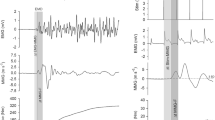Abstract.
The goal of the present study was to investigate the significance of low-force continuous or intermittent static contraction and feedback mode (visual or proprioceptive) on the development of muscle fatigue as assessed by electromyography (EMG) and mechanomyography (MMG). Visual (force control) and proprioceptive (displacement control) feedback was investigated during intermittent (6 s contraction, 4 s rest) and continuous static contractions at 10% and 30% of the maximum voluntary contraction (MVC). Mean force, force fluctuation, rating of perceived exertion and root mean square (RMS) and mean power frequency (MPF) of the EMG and MMG signals were analysed. The general pattern for MMG RMS and EMG RMS values and the rating of perceived exertion was an increase with contraction time, while the EMG MPF values decreased (P<0.05). The increase in RMS values was generally more pronounced for the MMG compared with the EMG, while the decrease in MPF values was more consistent for the EMG compared with the MMG signal. During the intermittent contractions, the main effect was on MPF for both EMG and MMG. Lower force fluctuation and larger rating of perceived exertion (P<0.05), greater slopes of EMG and MMG RMS and MPF values versus time were observed with proprioceptive feedback compared with visual feedback. The findings suggest that (1) the EMG and MMG signals give complementary information about localised muscle fatigue at low-level contraction: they responded differently in terms of changes in the time and frequency domain during continuous contraction, while they responded in concert in the frequency domain during intermittent contractions, and (2) the different centrally mediated motor control strategies used during fatiguing contraction may be dependent upon the feedback modality.
Similar content being viewed by others
Author information
Authors and Affiliations
Additional information
Electronic Publication
Rights and permissions
About this article
Cite this article
Madeleine, P., Jørgensen, L., Søgaard, K. et al. Development of muscle fatigue as assessed by electromyography and mechanomyography during continuous and intermittent low-force contractions: effects of the feedback mode. Eur J Appl Physiol 87, 28–37 (2002). https://doi.org/10.1007/s00421-002-0578-4
Accepted:
Issue Date:
DOI: https://doi.org/10.1007/s00421-002-0578-4




